Martha Stewart reveals the best vegetables to grow for beginners – our top 5 might surprise you
We've picked our top five and asked kitchen garden experts to tell us how to get it right
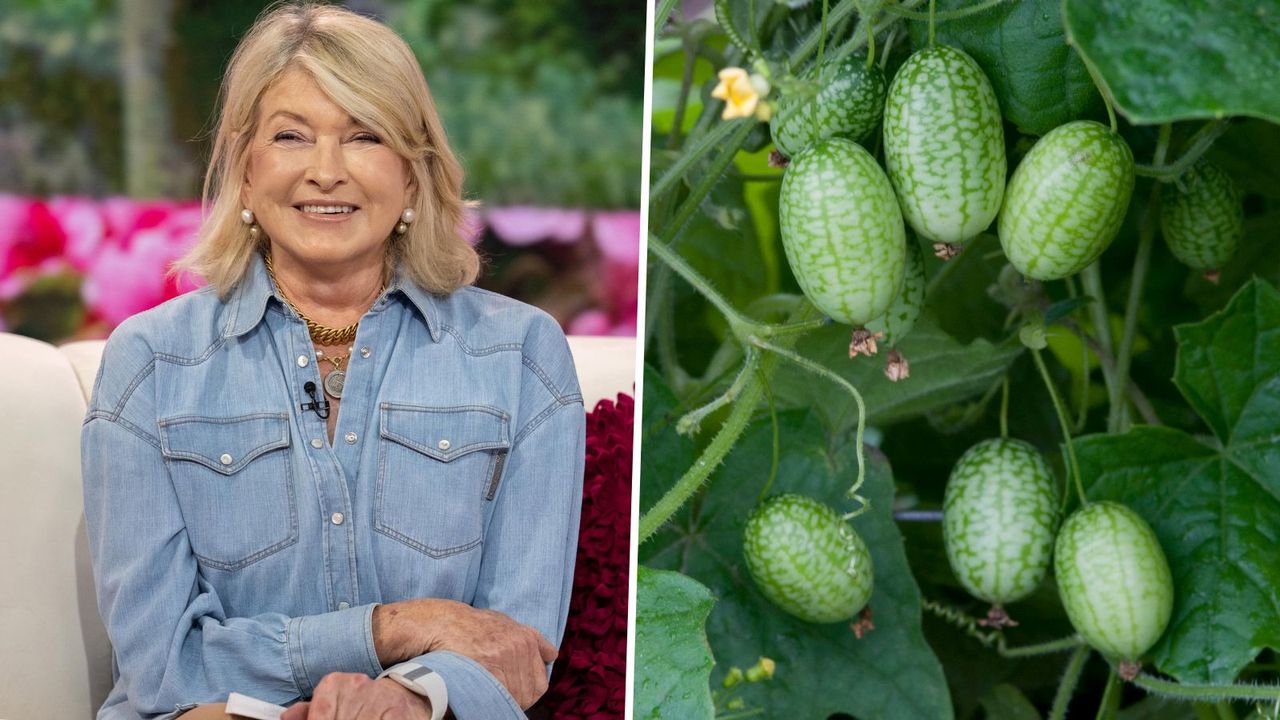

When Martha Stewart offers up gardening tips, we listen. This week, she shared her favorite five easy vegetables that you don't need a green thumb to grow. The list includes classics such as cherry tomatoes, lettuce, green beans, carrots and cucumber, but she also listed some lesser-known vegetables that are really simple to grow and maintain, and we've chosen our favorite five easy and fast-growing vegetables.
Best vegetables to grow for beginners
Finding the easiest vegetables to grow is important, whether you are an amateur or expert gardener since having a thriving vegetable garden shouldn't be too much of a hard graft.
'If you love the idea of growing, harvesting, and preserving vegetables from your own backyard, but can barely keep a single plant alive, these easy-to-grow greens offer a simple entry into the world of kitchen gardens. From old classics – like cucumbers and lettuce – to new favorites, like amaranth and cucamelons, these recommendations will get amateur gardeners off to a great start,' said Martha on her Instagram.
1. Amaranth
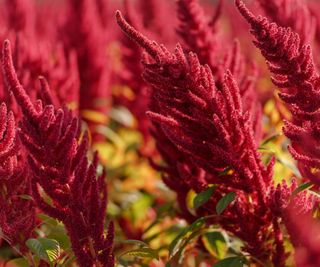
'You see many types of amaranth grown as annual ornamental plants, but many people may not know that it is also edible. The leaves and seeds of amaranth are edible, though most grow it for its high-protein seeds,' says Drew Swainston, gardening expert at Homes & Gardens.
Amaranth is the easy to grow, crimson, purple, red or green edible plant that can be harvested for it's grain and edible leaves.
Amaranth has a few different uses and species, all of which can be differently utilised to for cooking needs. Amaranthus tricolor with red foliage it very nutritious and has a taste similar to spinach. Another species of amaranth, A. cruentus, has black seeds which are also high in protein, which can be used in salads and curries. The green leaves from an amaranth plant can be cooked like spinach leaves.
Where to plant amaranth
Amaranth is adaptable to most soils but fairs the best in well drained soil in a space with good air circulation.
'It is a plant that likes lots of sun and wants the soil to be 65-75°F for optimum growth', continues Drew. In general, you should put your amaranth in a spot where it will receive six hours of sunlight every day, however if you are in an area with longer hot periods of sun, they will take solace in some shade.
How often to water amaranth
Water them one inch per week.
How to plant amaranth
Drew Swainston says 'Plant amaranth outdoors from early summer'.
We recommend staggering planting – this means you should sow some of your amaranth seeds every two to three weeks, each about four inches apart. This should mean the amaranth continues to grow.
Part of the ease and beauty behind this plant that makes us understand why Martha has recommended amaranth as one of the easiest vegetables to grow is because of the magnitude of seeds that will regularly fall and re-seed itself.
When to harvest
Amaranth seeds should be ripe and ready to harvest three months after they are planted. To test if they are ready or not you can rub the flowerheads with your hands. If they easily fall out then they're ready to be harvested.
'The seeds hang in long tassels and can be harvested from the plant to use as a grain once the tassel starts to turn brown, while leaves can be removed regularly as the plant grows to be eaten raw or cooked', adds Drew.

Drew qualified as a journalist and wrote for many websites and publications, before studying for a horticulture qualification. He worked as a professional gardener for several years, specializing in kitchen gardening. He's now bringing his expertise and passion to Homes & Gardens as a member of our team.
- Find Organic Amaranth Seeds at Walmart
2. Zucchini
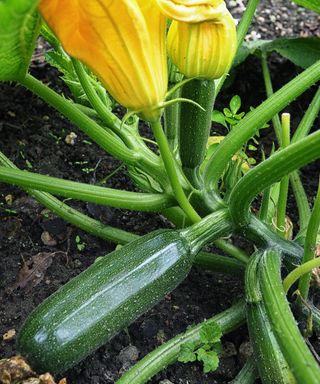
Zucchinis are an easy to grow staple of any summer garden patch due their versatility and great flavour, plus it's exciting to see if you can grow any to a prize winning size. This summer squash, otherwise know as a courgette, is a great garden to kitchen delicacy that can be used in a range of dishes from lasagne to pizza.
Where to plant zucchini
This plant does best in the sun, and needs around six to eight hours of it a day, so plant accordingly,
How often to water zucchini
Since they have shallow roots, zucchini thrive when it's soil is kept moist, this can mean watering it about an inch per week.
When to harvest zucchini
The best time to harvest your zucchini is when its 5" to 7" long. If you can't wait that long you can also harvest your zucchini when they are smaller, if you keep doing so they will continue to produce the plant all summer long – so you can really go too wrong when growing zucchini.
Although there are a few steps to follow when learning how to grow zucchini, they are really very easy to grow and fast-growing, so should be pretty hassle free those who feel overwhelmed by the task of growing fruit and veg.
- Find Squash, Zucchini at Burpee
3. Cucamelon
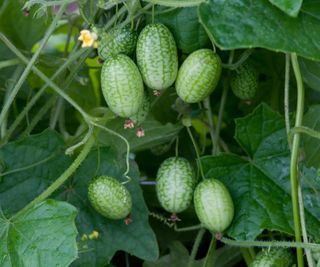
Cucamelons are an uncommon eye-catching vegetable – but despite its miniature watermelon-esque appearance, it is actually part of the cucumber family, originating from Mexico and Central America.
Cucamelons resemble the flavor of cucumbers but are also slightly sour and lemony, making them perfect for salads or to be pickled.
Surprise surprise, as promised by Martha Stewart, cucamelons are easy to grow and do not need much maintenance.
Where to plant cucamelons
Since cucamelons prefer warmer climates, they are usually grown as annuals. When growing cucamelons, make sure they are planted in full sun.
How to plant cucamelons
To plant cucamelons, sow the seeds under 1m of compost. Cucamelons can also be planted in containers, planters and grow bags and transferred to soil when they get bigger. This can be ideal for growing cucamelons when the outdoor conditions are not warm enough, meaning you can start growing your cucamelons inside in colder climates so they are at a further stage of growth for when summer arrives and they can be planted outside.
How often to water cucamelons
They should be watered regularly, at least once a week, and fertilised twice throughout its growing season with All- Natural Muriate of Potash Potassium Fertilizer from Amazon.
When to harvest cucamelons
They can be harvested when they are the size of a grape. Make sure they are firm otherwise they may turned.
- Find cucamelon, otherwise known as Cucumber, Mexican Sour Gherkin, at Burpee
4. Radishes
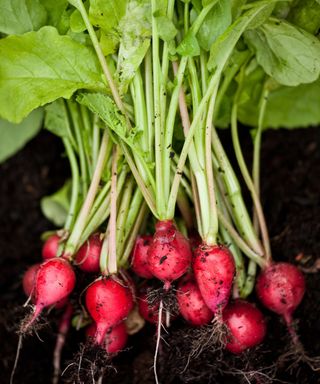
Another easy veggie that are salad staple are radishes. These fresh, crunchy vegetables taste quite sharp when eaten raw, in or are milder and more potato-like when roasted and are a great dish even just to have on its own with a garlic garnish.
Where to plant radishes
Radishes should be planted in non compacted soil so the water can drain. You also want them growing in partly shaded space where they do not get the heat of the midday sun, but where a bit of morning or evening sun will hit them. Overall, radishes are happy to grow in the shade, just ensure it's somewhat dappled so some light can get through.
How to plant radishes
How to grow radishes starts with how to plant them, and this depends on the temperature outside. Typically, they should be sowed from spring to late summer, but it should be done when it is not too hot or dry outside. Sow them about 1cm into the soil.
How often to water radishes
Watering should be done when the top inch of the soil is dry, which will be around once a week, but will depend on the humidity and temperature in your area. Make sure to be consistent in how often you water your radishes otherwise the radishes can become damaged.
When to harvest radishes
When to harvest your radishes will depend on their size, their age, and the season.
- Find Burpee Cherry Belle Radish Seeds at Amazon
5. Microgreens
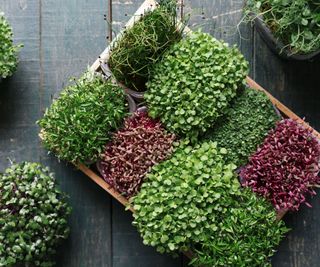
Microgreens are a great flavourful addition that can be used in a wide range of dishes, and are often even more nutritious than more mature vegetables, which makes it even better that they are so easy to grow, regardless of your gardening expertise. These can be used in soups, as a side to a meal or as a replacement for salad in in tacos, burgers or a sandwich, or can even be used in a smoothie! All you need to know is the simple steps of how to grow microgreens.
'Microgreens are a fantastic and very simple way to start growing vegetables. And they are super-speedy, you can get a crop in under two weeks. The easiest microgreens to start growing is cress, it is packed full of nutrients and growing cress can be a great experiment to get kids interested in growing. The likes of radish and rocket are also great microgreens, but my favorites to grow are pea shoots and nasturtiums.' says Drew Swainston, gardening expert at Homes & Gardens.
Where to plant microgreens
One of the benefits of microgreens small size is that they are quite flexible in where they can be grown. This can even be in just about any container as long as it is over one inch in depth, which can even mean a recycled food pot!
Keep your microgreens on a windowsill that gets plenty of sunlight, or outside in the shade. Drew Swainston recommends 'You may need artificial grow lights during the winter months.'
How to plant microgreens
'It is as simple as sowing the seeds on top of a tray of soil - you can sow microgreen seeds thicker than you would do other seeds - and covering them with a thin layer of soil', adds Drew. This can even mean a mix of different microgreens. Then cover with a small amount of compost and water.
How often to water microgreens
'Keep them moist, but not wet, by misting them regularly', advises Drew. Lightly water microgreens when the compost becomes dry, which can be as often as once every day or every other day.
When to harvest microgreens
You can harvest your microgreens they are about one to two inches tall.
- Find Microgreens 10 Pack at Walmart
FAQs
What are the gardening essentials for new gardeners?
Firstly, every gardener needs some hand tools. A rake is necessary for keeping your soil well aerated and can be used to loosen compact soil. A transplanter or trowel is important for taking care when moving plants what maybe aren't in the right place or have matured and have to be moved. We recommend this 3-Piece Set Black Iron Gardening Tools Set from Walmart.
Gardening shears are an essential for when it comes time to harvest your vegetables, such as this 3 Pack Garden Pruning Shears from Amazon.
These easy, and often quick growing plants are perfect for anyone who wants to dip their toe into the gardening world, maybe you've been inspired by a number of celebrities gardening skills, such as Jennifer Garner's family fruit garden or Martha Stewarts container tips for perfect tomatoes, or simply want to get into the garden to kitchen lifestyle for some fresh flavors on hand. Well whatever your gardening skill level is, trying some these easy growing vegetables from Martha's list will as rewarding as it will be tasty!
Sign up to the Homes & Gardens newsletter
Design expertise in your inbox – from inspiring decorating ideas and beautiful celebrity homes to practical gardening advice and shopping round-ups.

Lola Houlton is a news writer for Homes & Gardens. She has been writing content for Future PLC for the past six years, in particular Homes & Gardens, Real Homes and GardeningEtc. She writes on a broad range of subjects, including practical household advice, recipe articles, and product reviews, working closely with experts in their fields to cover everything from heating to home organization through to house plants. Lola is a graduate, who completed her degree in Psychology at the University of Sussex. She has also spent some time working at the BBC.
-
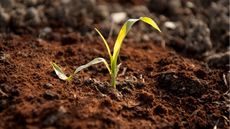 This one item you throw away daily is guaranteed to stop slugs in their tracks – save it from the bin and use it for effective pest control instead
This one item you throw away daily is guaranteed to stop slugs in their tracks – save it from the bin and use it for effective pest control insteadThe smell and texture of coffee grounds discourages slugs coming close to your crops
By Tenielle Jordison Published
-
 Anne Hathaway's 'warm minimalist' living room showcases the most desirable furniture trend that we hope will never go out of style
Anne Hathaway's 'warm minimalist' living room showcases the most desirable furniture trend that we hope will never go out of styleCurved lines are a crucial consideration in interior design to make a room well-balanced and visually pleasing
By Jennifer Ebert Published